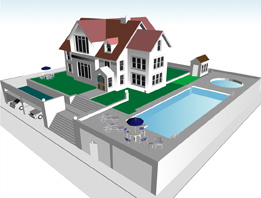Lesson 1
1. Lesson 1
1.10. Explore 5
Module 4: Quadratic Equations and Inequalities
You have learned that a quadratic equation can have one root if the vertex of the corresponding graph touches the x-axis; two roots if the graph crosses the x-axis in two distinct points; and no roots if the graph does not cross the x-axis at all.
For the rest of this lesson you will use graphing to solve quadratic equations in different contexts.
Example: Determining the Dimensions of a Building Footprint

Hemera/Thinkstock
The footprint of a building describes the shape and size of its ground floor. The area of the rectangular footprint of a particular building is 546 m2. The length of the footprint is 5 m more than its width. Determine the dimensions of the footprint. You may want to try to answer this problem before looking at the solution.
When you are ready for the solution, watch Building Footprint Sample Solution.
Try This 4
Turn to “Example 4” on page 213 of the textbook to see an example of how a quadratic equation can be used to solve a problem dealing with a suspension bridge. In this problem the solution is not represented by the zeros of a quadratic function. However, determining the zeros is part of the solution process. As you work through the problem, respond to the following questions:
- How are the variables in the quadratic equation similar to and different from those of the quadratic equation found in Try This 1, which was related to atlatls?
- What does the x-axis represent in this problem?
- What must you do with the zeros of the function in order to solve the problem? Why?
![]() Save your work in your course folder.
Save your work in your course folder.
Self-Check 4
Complete questions 5, 7, and 12 on pages 215 to 217 in the textbook. Show your work to support your answers. Answer
